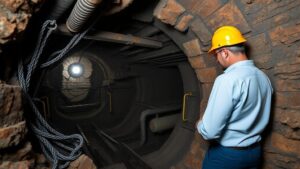Understanding the Role of Fire-Setting in Agricola’s Hard Rock Mining Methods
Understanding the Role of Fire-Setting in Agricola’s Hard Rock Mining Methods
The practice of fire-setting in mining has long been recognized as a significant technique, particularly in the context of Georgius Agricola’s writings during the Renaissance. Agricola, often referred to as the father of mineralogy, provided pioneering insights into mining operations, including the use of fire-setting as an essential method for extracting minerals from hard rock formations. This article aims to explore the historical applications, techniques, and implications of fire-setting in hard rock mining as outlined by Agricola.
Historical Context of Fire-Setting
Fire-setting, the process of using heat to weaken rock formations, has been employed since ancient times. Agricola’s work, De Re Metallica, published in 1556, serves as a foundational text describing various mining methods, including fire-setting. This technique was particularly useful in breaking apart hard rock masses, facilitating easier extraction of valuable minerals such as silver and copper.
Fire-settings effectiveness is derived from the thermal expansion of rocks. When rocks are heated by fire, they expand; upon cooling, they contract. This cycle produces fissures and loosens the rock’s structure, making it more amenable to excavation.
The Process of Fire-Setting
Fire-setting involves several crucial steps, which Agricola detailed in his treatise:
- Preparation of the Rock Face: Miners would clear the area around a rock face, often preparing a vertical shaft for better access to the ore.
- Ignition: Large quantities of wood or coal would be piled against the rock face and ignited. The choice of fuel was critical for generating sufficient heat while minimizing environmental risks.
- Cooling Process: Once the rock had been heated, miners would douse it with water. The rapid cooling created stress fractures in the rock.
- Extraction: Following the cooling process, the weakened rock could be more easily fractured and removed using mechanical tools like pickaxes.
This systematic approach underscores the ingenuity of early miners and reveals how practical observation laid the groundwork for future mining technologies.
Advantages of Fire-Setting
Fire-setting provided numerous advantages, making it a favored method during Agricola’s time:
- Cost-Effectiveness: Since fire-setting primarily utilized locally available materials (wood, fuel), it reduced the costs associated with more complex machinery.
- Increased Efficiency: By weakening the rock structure, fire-setting allowed for faster extraction rates compared to traditional methods.
- Accessibility: This method was adaptable to various mining operations, including the extraction of minerals from deep-vein deposits.
Challenges and Risks Associated with Fire-Setting
Despite its benefits, fire-setting was not without its challenges. Miners faced various risks, such as:
- Fire Hazards: The use of fire in enclosed spaces raised the danger of uncontrolled fires, which could threaten lives and resources.
- Structural Collapse: Improper application of fire-setting could lead to excessive weakening of rock, causing unpredictable collapses.
- Environmental Impact: The burning of wood contributed to deforestation and other ecological consequences, raising concerns about sustainable practices.
Modern Applications and Legacy
While fire-setting is largely obsolete in modern mining practices due to advancements in technology, its principles are still relevant. Techniques such as controlled blasting have evolved to enhance mineral extraction while minimizing risks to both workers and the environment. The legacy of Agricola’s fire-setting method continues to influence modern mining practices by highlighting the importance of innovative techniques tailored to the challenges of resource extraction.
Conclusion
The role of fire-setting in Agricola’s hard rock mining methods serves as a fascinating case study in the evolution of mining technology. By understanding the historical context, techniques, and implications of this approach, one can appreciate its impact on modern mining practices. For contemporary professionals in the mining industry, returning to the foundational principles established by Agricola can inspire innovative strategies that balance efficiency, safety, and environmental stewardship in the ongoing pursuit of mineral resources.
As a takeaway, professionals in the field may consider the following actionable insights:
- Explore historical methods of extraction to inspire modern innovations.
- Evaluate risk management practices derived from early mining techniques.
- Promote sustainable practices in resource extraction based on lessons learned from the past.

